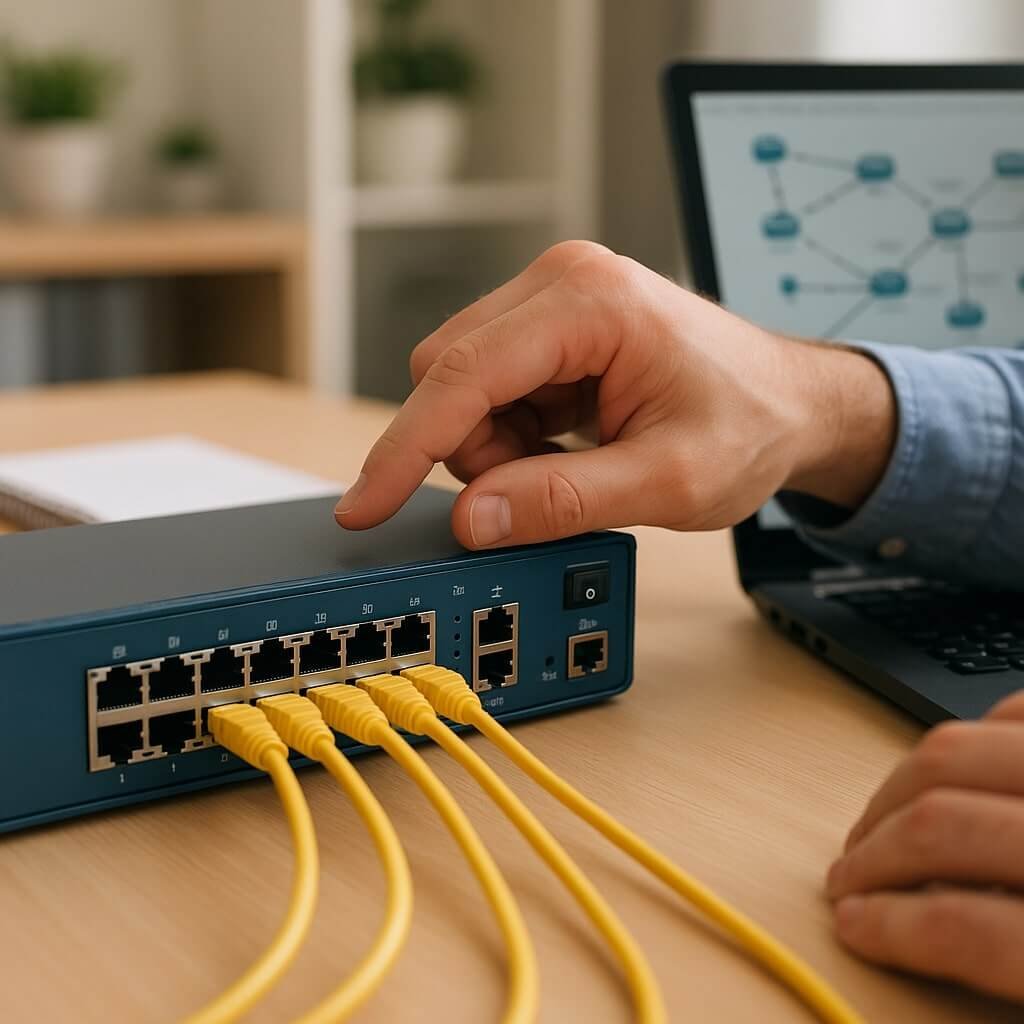When it comes to wireless network security, understanding vulnerabilities is vital. You must implement strong passwords and robust encryption like WPA3 to safeguard your network. Regular updates and monitoring are essential for identifying threats. Without these measures, your data is at risk. As you explore these principles, consider how each aspect can greatly bolster your network’s defenses against potential breaches. What steps will you prioritize to enhance your security posture?
Key Takeaways
- Implement strong encryption protocols like WPA3 to enhance wireless network security and protect against unauthorized access.
- Regularly update firmware and software to address vulnerabilities and improve device performance.
- Use strong, complex passwords and change them frequently to mitigate unauthorized access risks.
- Monitor network traffic for anomalies and maintain logs to detect unusual access patterns.
- Educate users on security threats and safe browsing practices to foster awareness and proactive defense.
Understanding Wireless Network Vulnerabilities
While wireless networks offer convenience and flexibility, they also expose users to various vulnerabilities that can jeopardize data integrity and privacy.
You must recognize that wireless threats, such as eavesdropping and man-in-the-middle attacks, can result from insufficient encryption and authentication protocols. The lack of physical boundaries increases network exposure, allowing unauthorized users to access sensitive information easily.
Wireless threats like eavesdropping and man-in-the-middle attacks thrive on weak encryption and the absence of physical barriers.
Additionally, outdated firmware and insecure configurations contribute to these vulnerabilities, making your network an attractive target for attackers.
Regularly evaluating your wireless setup, including signal strength and coverage, is essential for identifying potential weaknesses.
Importance of Strong Passwords
Strong passwords are essential for securing your wireless network, as their complexity considerably enhances overall security.
Regularly changing these passwords further mitigates risks associated with unauthorized access.
Complexity Enhances Security
To guarantee robust protection of your wireless network, implementing complex passwords is essential. Strong passwords serve as the first line of defense, creating security layers that make unauthorized access considerably more difficult.
By incorporating a mix of upper and lower-case letters, numbers, and special characters, you enhance your password’s complexity. This complexity not only strengthens your security posture but also aids in network obfuscation, making it harder for attackers to decipher your credentials.
Regular Password Changes
Even with complex passwords in place, their effectiveness diminishes over time if not regularly updated. To maintain robust security, you should establish a consistent password change frequency—ideally every 60 to 90 days.
This practice minimizes the risk of unauthorized access, as it limits the time an attacker could exploit a compromised password. Utilizing password management tools can streamline this process, allowing you to generate and store strong, unique passwords for each account without the hassle of memorization.
These tools can also remind you when it’s time to change your passwords, ensuring you stay ahead of potential threats. Regular password updates are a critical component of your overall wireless network security strategy.
Implementing WPA3 Encryption
While implementing WPA3 encryption greatly enhances wireless network security, it’s crucial to understand the specific configuration steps required for ideal deployment.
This modern security protocol offers significant WPA3 benefits, including improved data protection and resistance to brute-force attacks through its advanced authentication mechanisms.
To effectively implement WPA3, follow these steps:
- Check Compatibility: Confirm your devices support WPA3 features.
- Update Firmware: Install the latest firmware on your router and connected devices.
- Configure Settings: Access your router’s settings and select WPA3 as the security protocol.
- Test Connectivity: Verify that all devices connect successfully and maintain a secure connection.
Regular Software and Firmware Updates
Regular software and firmware updates are vital for maintaining the security and functionality of your wireless network. By consistently applying these updates, you can mitigate software vulnerabilities that hackers exploit. Additionally, firmware enhancements provide significant improvements to device performance and security protocols.
| Update Type | Frequency | Benefits |
|---|---|---|
| Security Patch | Monthly | Fixes vulnerabilities |
| Feature Update | Quarterly | Introduces new functionalities |
| Firmware Upgrade | Biannually | Enhances device performance |
| Minor Software Update | As needed | Improves stability |
| Major Software Update | Annually | Adds significant improvements |
Prioritizing these updates helps guarantee your network remains robust against emerging threats, allowing you to maintain a secure and efficient wireless environment.
Disabling SSID Broadcasting
Disabling SSID broadcasting can enhance your wireless network’s security by making it less visible to potential intruders.
However, this approach also comes with drawbacks, such as complicating connections for legitimate users.
To maintain robust security, it’s crucial to evaluate alternative measures alongside this tactic.
Benefits of Disabling SSID
When you disable SSID broadcasting, you greatly enhance your wireless network’s security by making it less visible to potential attackers.
This reduction in network visibility helps protect your SSID security. Here are some key benefits of this approach:
- Reduced Exposure: Fewer devices can discover your network, minimizing unauthorized access attempts.
- Increased Privacy: Only those who know your SSID can connect, creating an additional layer of privacy.
- Deterrence: Potential attackers may be discouraged by the lack of visible networks, reducing the likelihood of targeted attacks.
- Simplified Management: You can focus on monitoring known devices without the noise of numerous unauthorized connection attempts.
Potential Drawbacks Explained
While the benefits of disabling SSID broadcasting are evident, it’s essential to contemplate the potential drawbacks that accompany this choice.
You might face user convenience trade-offs, as users need to manually enter the network name, complicating access.
Device compatibility concerns can arise, particularly with older equipment that may struggle to connect without the SSID being visible.
This choice can also lead to security protocol limitations and encryption strength issues, as traditional methods mightn’t be as effective.
In addition, implementation costs could increase due to necessary training resource needs and performance impact assessments.
Scalability obstacles may emerge, and regulatory compliance challenges could complicate your network’s overall security strategy.
Alternative Security Measures
Implementing alternative security measures, such as disabling SSID broadcasting, can enhance the overall protection of your wireless network. By hiding your network name, you can deter casual users from attempting to connect.
However, complement this measure with additional strategies:
- Biometric Authentication: Use fingerprint or facial recognition to control access to your network devices.
- VPN Usage: Always connect through a Virtual Private Network to encrypt your data and mask your IP address.
- MAC Address Filtering: Limit access to specific devices based on their unique MAC addresses.
- Strong Encryption Protocols: Utilize WPA3 for robust encryption to safeguard your data.
Network Segmentation for Enhanced Security
Network segmentation greatly enhances security by dividing a larger network into smaller, isolated segments. This approach improves network architecture by limiting access to sensitive data and reduces the attack surface. By implementing traffic isolation, you minimize the risk of lateral movement by potential attackers.
Here’s a brief overview of the benefits:
| Benefit | Description | Impact |
|---|---|---|
| Enhanced Security | Limits access to sensitive areas | Reduces breach risk |
| Improved Performance | Reduces congestion in segments | Increases efficiency |
| Easier Compliance | Simplifies auditing and monitoring | Guarantees regulatory adherence |
Utilizing Firewalls and Intrusion Detection Systems
Firewalls and Intrusion Detection Systems (IDS) serve as critical components in an all-encompassing security strategy, as they actively monitor and control incoming and outgoing network traffic to prevent unauthorized access.
To effectively implement these systems, consider the following:
- Optimize Firewall Configurations: Regularly update rules and policies to address emerging threats.
- Deploy IDS for Real-Time Monitoring: Use intrusion detection to identify anomalies and potential breaches instantly.
- Integrate with Security Information Systems: Combine IDS data with broader security analytics for thorough insights.
- Conduct Regular Audits: Periodically assess firewall configurations and IDS effectiveness to guarantee alignment with security policies.
Educating Users on Security Best Practices
While technology plays an essential role in securing wireless networks, educating users on security best practices is equally important for mitigating risks.
Building user awareness through thorough security training helps you recognize threats like phishing and social engineering. Regularly assess risks associated with your devices and guarantee proper device management protocols are in place.
Secure browsing practices are critical; always verify website authenticity before entering sensitive information. Implementing access control measures protects data, while effective incident response plans prepare you for potential breaches.
Prioritizing data protection enhances overall security posture, enabling you to respond proactively to threats. By fostering a culture of security awareness, you empower yourself and your organization to effectively navigate the complexities of wireless network security.
Monitoring and Auditing Network Activity
Effective user education lays the groundwork for a robust security framework, but ongoing monitoring and auditing of network activity are essential to maintaining that security.
Effective user education is crucial, but continuous monitoring and auditing are vital for sustaining security.
You need to implement systematic processes to guarantee your network remains secure. Here are key steps to follow:
- Conduct regular network traffic analysis to identify patterns and baseline normal behavior.
- Utilize anomaly detection tools to spot deviations that could indicate potential threats.
- Review log files frequently for unusual access patterns or unauthorized devices connecting to your network.
- Perform periodic security assessments to evaluate the effectiveness of your monitoring strategies and make adjustments as necessary.
Conclusion
In summary, prioritizing wireless network security is vital for safeguarding sensitive data. By implementing strong encryption like WPA3, using complex passwords, and keeping software updated, you markedly reduce vulnerabilities. Disabling SSID broadcasting and segmenting your network further enhances protection. Don’t underestimate user education; empowering individuals to recognize threats is essential. Regular monitoring and employing firewalls strengthen your defenses. By adhering to these principles, you’re not just complying with standards but actively fortifying your network against potential breaches.






